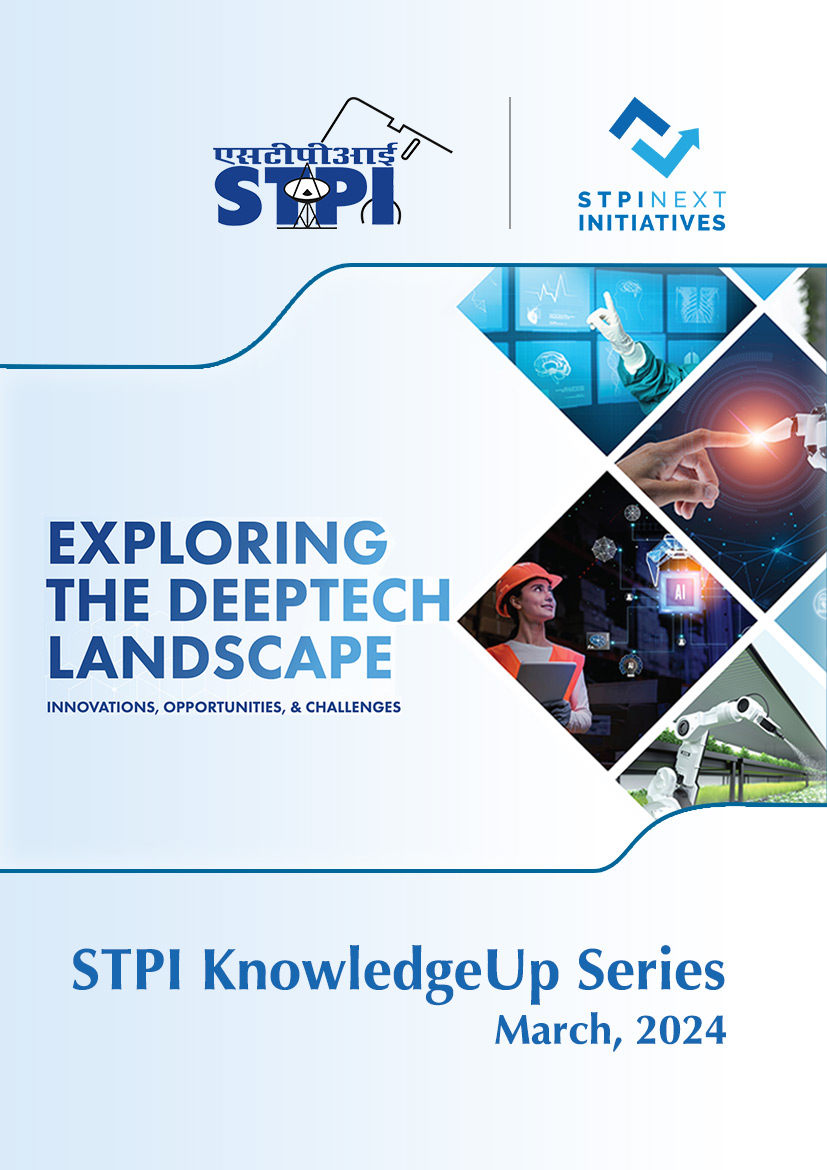
Exploring The DeepTech Landscape: Innovations, Opportunities & Challenges
पढ़ने के लिए ऊपर क्लिक करें
DeepTech Overview – Levels, Benefit, Difference from High-Tech and Low-Tech Startups, Focus Areas
- DeepTech typically focuses on complex & revolutionary technologies, with the aim of addressing societal and environmental issues by tackling complex challenges faced by humanity.
- DeepTech innovations are categorized into four levels based on the degree of value addition, impact, complexity, and time to scale.
- Tech substitute: Incremental upgrades or replacements
- System upgradation: Upgrade of existing systems & processes
- System transformation: Altering or changing a system or process
- System of system transformation: Complete overhaul of an existing system or process
- DeepTech offers a plethora of benefits such as job creation, metadata management, resource management, transparency & traceability, and it strengthens the start up ecosystem
- DeepTech startups address humanity's problems, high-tech startups focus on specific business issues, and low-tech startups cater to basic needs
- The focus area for DeepTech is where market demand solves global challenges through science and technology breakthroughs
- DeepTech has applications across various industries not limited to:
- Healthcare: Remote patient monitoring, disease diagnosis, and blockchain power health management system
- Energy: Renewable energy optimization, energy storage management, and carbon capture
- Agriculture: Precision spraying, monitoring crop health, automated harvesting, and supply chain management using AI
- Manufacturing & industrial automation: Predictive maintenance, supply chain optimization and process optimization
- Logistics: Inventory management, delivery drones, route optimization, automated report generation and predictive maintenance
- Material science & nano-technology: Atomistic representation, Computational materials design and biomedical nanotechnology
- Information technology: Cloud computing. AI, blockchain and quantum computing
DeepTech Market Landscape
- Global investments in DeepTech in CY23 amounting to ~US$ 75B, and number of global DeepTech deals were ~3,425
- In CY23, DeepTech startups based out of the USA, China and France received the most investment from PE/VC firms, amounting to ~US$ 40B
- In US, funding of DeepTech companies in CY23 amounted to ~US$ 45B with ~1,385 deals
- The funding of DeepTech companies in Europe in CY23 was ~US$ 15B, with ~970 deals
- In India, funding of DeepTech companies during CY23 amounted to ~US$ 1B, while number of DeepTech deals was ~175
- India is collaborating and partnering with global stakeholders to promote innovation and technology in the DeepTech industry through alliances such as the U.S-India Artificial Intelligence (USIAI) Initiative, for UK-India Tech Alliance, the India-Russia Joint Technology Assessment & Accelerated Commercialization Programme, and more
- Top-tier academic institutions partner with industry leaders in fields of AI / ML, robotics, quantum computing, blockchain & extended reality in India such as Partnership between IIT-Madras’ Robert Bosch Centre for Data Science & Artificial Intelligence, Kotak-IISc AI/ML Centre by Kotak Mahindra Bank Limited & IISc, Collaboration between HARMAN & BITS Pilani are some examples
Growth Drivers, Challenges, Future Trends & Growth Strategies
- Key growth drivers for DeepTech companies include integration of new technologies, better accessibility to resources, and availability of high capital.
- In service-based companies, average investments have significantly increased, often exceeding US$ 100M
- For product-based companies, easy access to advanced computing hardware, manufacturing, and 3D printing serves as key growth drivers
- Challenges for product-based companies stem from longer adoption times, high expansion costs, and the requirement of substantial funds compared to service-based companies
- Key future trends in DeepTech include advancements in AI, quantum computing, space exploration, computational biology, robotics, and other emerging fields.
- New AI architectures and algorithms will focus on developing explainable AI, privacy-enhancing AI, and other advancements
- Computing development will expand to include quantum computing, wearables, ambient computing, IoT, cloud, etc.
- SpaceTech will concentrate on reducing satellite development costs for applications such as space manufacturing, earth observation, asteroid mining, etc.
- Computational biology will leverage new computational technology for drug discovery, enhancing efficiency in research and development, etc.
- Government partnerships and corporate collaborations are key growth strategies for DeepTech startups.
- Government programs like the Clean Energy Research Initiative and the Atal Innovation Mission will strengthen the DeepTech ecosystem
- Corporate investments in DeepTech startups will provide support and nurture growth
- Targeting niche markets is another crucial growth strategy for DeepTech startups
- Niche markets offer less competition and can facilitate rapid growth and scalability

